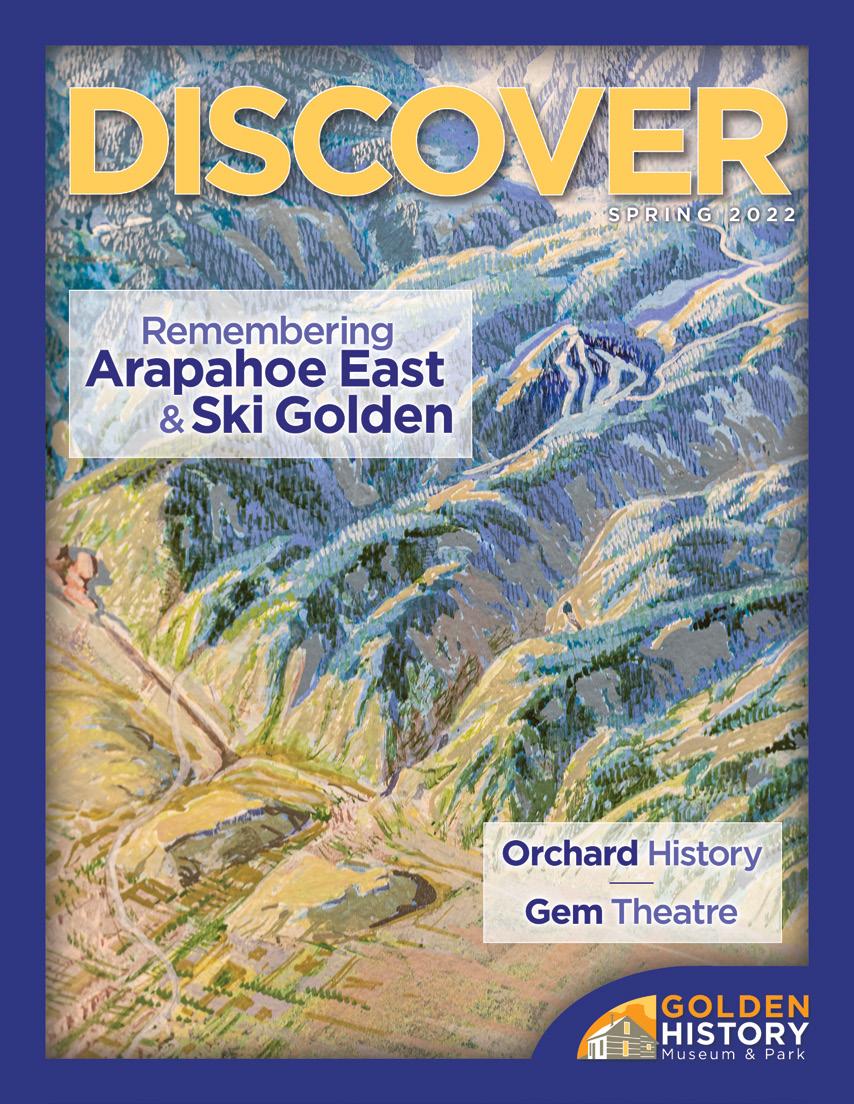
Staff
 Nathan Richie Britton Taylor
Mark Dodge Vanya Scott Director Education Assistant Curator Curatorial Assistant
Nathan Richie Britton Taylor
Mark Dodge Vanya Scott Director Education Assistant Curator Curatorial Assistant
 Jesse Gagnon Kathleen Eaton
Doug Skiba
Andrew Terrill Student and Interpretation and Development and Graphic Design Family Programs Visitor Experience Communications, and Layout Coordinator Coordinator Editor (Discover) (Freelance)
Jesse Gagnon Kathleen Eaton
Doug Skiba
Andrew Terrill Student and Interpretation and Development and Graphic Design Family Programs Visitor Experience Communications, and Layout Coordinator Coordinator Editor (Discover) (Freelance)
Director’s Welcome
It’s spring again and we are excited to share with you some new exhibits at the Golden History Museum. We will welcome two new artists this year in The Salon. First, see the works of George Curtis Levi, Arapaho and Cheyenne artist who creates beautiful narrative drawings in the traditional ledger art style of the Cheyenne people, on display through June 4. Next, from June 9 through October 2, we will feature new works by world renowned food photographer, Rick Souders. We have a new display of signs from iconic Golden businesses called Signs O’ The Times We’ll also feature highlights of artifacts rediscovered during our Legacy Collection Inventory. Plus, be sure to see Hal Shelton’s captivating “Colorado Ski Country USA” painting on loan to us from the Colorado
Snowsports Museum Hall of Fame through the end of the year.
We are optimistic that the COVID pandemic is starting to wane and some of the restrictions we were forced to implement will begin to relax. On May 1st, the museum will start summer hours and be open five days a week with Tuesday-Saturday operations from 10 a.m. - 4 p.m. We are introducing extended hours on Fridays and Saturdays from 9 a.m. - 5 p.m. Also new this summer, on the fourth Thursday in June, July, and August the museum will be open late until 7 p.m. Join us for free entertainment on the patio as well as fun family activities and games. On the second Saturday of June, July, and August we will present our revamped Homestead Open House at the Golden History Park. We’ve beefed up these
fun events with extra activities, building access, and historic demonstrations.
We are eager as ever to welcome back students for our Hands-on History summer camp. We’ve added some new themes and programs and returned to greater capacity now that many of the COVID restrictions have been relaxed (although, we also know that unforeseen circumstances can always change that). Be certain to check out our education section in this magazine for updates on fun family events and activities.
We can’t wait to welcome you to the museum this year!
Sincerely,
Nathan Richie, Director
2 DISCOVER I SPRING 2022
DISCOVER I SPRING 2022 IN THIS ISSUE
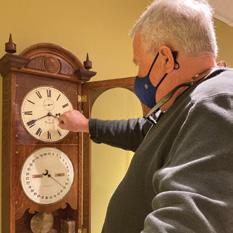

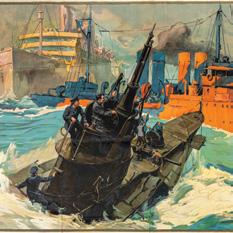
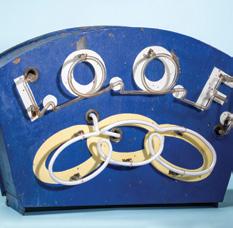

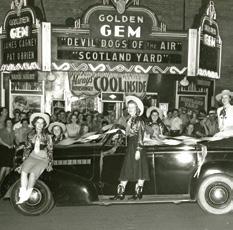
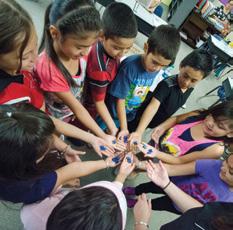
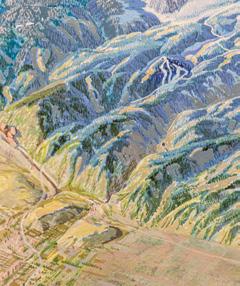
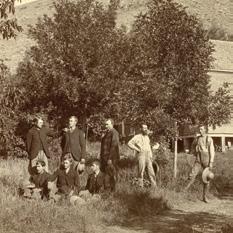
DISCOVER I GoldenHistory.org 3
Orchard History Heritage Orchard Education Roundup Remembering Arapahoe East & Ski Golden Collection Corner Artifact Conservation: Investing in the Future of the Past The Little Theater with the Big Pictures: The Gem Staff Profile Volunteer Profile Legendary People Programs In Memory of Bill Mckee Exhibit News The Salon Donors Autumn Fest 4 7 8 10 12 14 16 20 21 22 24 25 26 28
Cover image:
Detail from Hal Shelton’s painting Colorado Ski Country USA. On loan from the Colorado Snowsports Museum Hall of Fame.
4 8 10 12 14 16 24 25
Photo © Justin LeVett Photography
Orchard History
By Nathan Richie, Director
It is a ten to one chance you do not know that one of the finest fruit belts in the state lies at your very door. Fact, however! From just west of Elitch’s Gardens to a point seven miles southwest of the city stretches a fertile belt that yields precedence to none.
Rocky Ford for melons, Loveland for raspberries, Greeley for potatoes, Grand Junction and Paonia for peaches, if you like, but the Elitch-Golden belt for apples and plums!
A ramble through the orchards clustering about Beehive and Lakewood, on the line of the Denver & Intermountain Railway Company, is

a revelation and an eye-opener. Long rows of trees with branches dragged to the ground in a circle of tempting apples as thick as cherries. Trees twenty feet high pulled down by their immense yield, so that a tall man can touch the top! Branches broken down and trunks of good-sized trees cleft to the surface of the earth by the weight of bushels upon bushels of apples! Never was such a yield before within the memory of the oldest settler. Ben Davis, Winesap, Missouri Pippin, Early Transparent, Jonathan, Wealthy, Duchess of Oldenburgh, the Snow apple! From these and a dozen other varieties you may take
your choice. If you prefer plums there is the wild goose, the Lombard, the German prune, not to mention the other kinds, of which there are many.
A rich lava wash runs through this belt…The soil is a heavy loam, which holds water and does not require a great deal of irrigating. Because of these reasons and the abundance of the water supply this is one of the finest fruit and garden spots in the country. The irrigating ditches are filled from the mountain streams, such as Ralston Creek, Clear Creek, Bear Creek and the Platte.
- Colorado Transcript, April 6, 1905
4 DISCOVER I SPRING 2022
‘‘
‘‘
Colorado’s high, arid climate is not often associated with lush agricultural production. When Edwin James, member of the Stephen Long Expedition of 1820, passed through the region he wrote that the Great Plains were “uninhabitable by a people depending upon agriculture for their subsistence.” A map produced from the Long Expedition labeled the area as “The Great American Desert.” And while it is true that the local American Indians subsisted on hunted or gathered foods instead of grown crops, the land was not as inhospitable to farming as it has been described.
No one understood the potential for cultivation better than David K. Wall, one of Golden’s first White settlers. Wall arrived in the Golden valley from Indiana in 1859 where he pitched his tent on the north side of Clear Creek. Using farming implements
and seeds he brought with him, Wall planted the first known gardens in the area. He dug his own irrigation and diverted water from Clear Creek. By season’s end he had earned $2,000 for his crops which he happily sold to the hungry gold seekers who poured into the region.



Water was the key to agricultural success and others soon followed Wall’s lead. In 1871, Charles Welch, an entrepreneur, territorial legislator, and early founder of Golden financed the creation of the Vasquez Flume & Ditch Company. The company built one of the first flumes in the area that diverted water from Clear Creek (near Tunnel One) and brought water gently around the east face of Mt. Zion into the southern half of
Golden for drinking and irrigation. The ditch flowed southward through present day Colorado School of Mines campus out to the Colorado State Industrial School (today’s Lookout Mountain School for Boys). Quickly gardens and orchards large and small sprang up along the waterway.
Of the Industrial School orchards, the Colorado Transcript observed on July 26, 1893: “The head farmer is Jacob Sharps, who has demonstrated his ability as a manager of the boys and as a very successful farmer. The boys work willingly as they know that good crops mean that they will get many an appetizing meal. By the use of this labor the state saves for large sums which otherwise would have to be purchased. The health of the inmates is improved by the liberal use of vegetables and fruit. The boys are instructed in farming, fruit-raising and irrigation and they can always find a job at farm work. One boy who was in for one year is now getting $20.00 per month in the employ of a good market gardener, who says that boy will be worth $100 per month in short time.”

Quickly demand for water resources grew and in 1873 the Welch Ditch was extended back northward through Golden, then east past today’s Coors Brewery, hugging the southern and eastern flanks of South Table Mountain where it ran east into Lakewood. On the north side of Clear Creek, the Church Ditch was dug to divert water
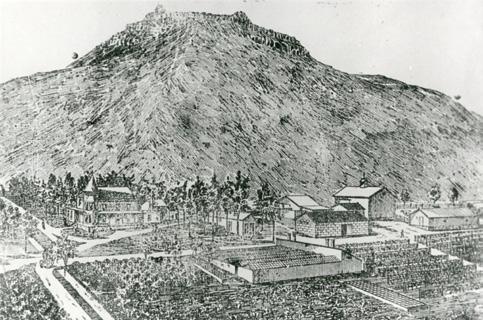
DISCOVER I GoldenHistory.org 5
Photos © Golden History Museum & Park, City of Golden Collection
The Easley family’s “Orchard House” in Golden, about 1890. Standing in the center in the dark suit is Elwood Easley. His brother Rees Easley (with beard) is standing to the right. The young men on the left are believed to be their sons.
Engraving of the Easley family’s “Orchard House” in Golden.
Bobby Maughan and Jack Trezise (Junior) playing in the family orchard. Continued overleaf
along the southeast side of North Table Mountain, bringing water to Applewood, Arvada, and Westminster. Other ditches like the Old Mill Ditch, Agricultural Ditch, and Wannamaker Ditch brought irrigation across the Clear Creek valley from Golden east to the confluence of the Platte River.
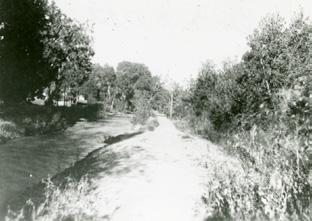
Very quickly, agriculture became a viable means of making a living in the region. One of the largest and best-known farms in the area belonged to the Easley family. Elwood Easley came to Colorado from Illinois in 1873. He purchased 400 acres of land between North Table Mountain and Clear Creek. Easley was an experienced farmer and soon brought much of his acreage into cultivation. The 1893 Golden Globe Industrial Edition noted that Easley had four acres of apple orchard, plus cherries, pears, plums, and other fruit. Each acre of apples netted $300500 in profit, whereas cherries netted nearly $900 per acre. Elwood constructed the very first greenhouses in Colorado and produced fruits and vegetables that he sold year-round to locals and to miners in the silver camps. Other notable families like the Wannamakers, Parfets, Lewises, and Everetts had large, thriving fruit orchards.
Growing fruit in the Golden region was never an easy prospect. The short growing season, early blooms, late freezes, and frequent blights made for very unstable annual market conditions.
To bolster Golden’s nascent agricultural economy, Colorado Transcript editor George West began running annual reports starting in 1891 on the condition of the market gardens, orchards, vineyards, and small fruit farms in the vicinity of Golden. But, despite the encouraging words, even West could see looming trouble for the industry. In 1893 West wrote, “The present fruit season has had many drawbacks; the blight, heavy
winds in the spring and late frosts injured the apple crop very materially. The first cause is now under subjection and we hope to chronicle its utter extinction during the present year. The winds and frosts also affected the small fruits.”
But a new scourge was affecting the local orchard business: an economic depression. In 1893, the Sherman Silver Purchase Act that required the US Government to double its monthly purchase of silver to 4.5 million ounces, was repealed. Colorado’s Silver Boom came to a screeching halt and the economy went into free fall. What became known as the Panic of 1893 was one of the most crippling economic depressions the country had ever experienced—and it hit Colorado especially hard. The silver miners, who once represented the lion’s share of produce consumers, left the region and population dwindled.

In 1922, the Agriculture Experiment Station of the Colorado Agricultural College (Colorado State University) published its Orchard Survey of the Northeastern District of Colorado. The purpose of the survey was to conduct a census of the types and varieties of fruit produced in the region and report on the general health, productivity, and prospects for the industry. The report noted:
“[The region] is an irregular belt, broken in many places by ridges which cannot be irrigated and therefore not suitable for the growing of fruits…Only the hardier tree fruits


can be grown successfully and the industry is confined principally to the growing of the hardier apples, plums, and sour cherries… While many of the more tender and long seasoned (apple) varieties can be grown, the fruit does not attain the size nor the color that is developed in more favorable sections. The apple orchards are usually of considerable age and testify to the early attempts of the settlers. The planting has barely kept pace with the dying and removal of trees in the older orchards.”
In 1966, Fred Easley, grandson of Elwood Easley, reminisced in a news article about growing up at the family farm and the stately home once known as “Orchard House.” He observed that “the fruit trees finally were so immense that it was impossible to pick the fruit or get anyone to do it. Ladders would not reach high enough into the trees. The last time they were picked the tops were cut out and the fruit picked on the ground. In 1922 the orchard was taken out, signaling an end to a way of life.”
There was no single death knell for the orchard industry, rather a slow and steady decline. The twentieth century witnessed a shift in area land use from agriculture to housing. Over time, farms were sold and subdivided into housing divisions. Vast orchards of fruit trees were replaced with the single-family homes of Applewood, Pleasant View, Fairmount, and Wide Acres. Yet, amid these areas, apple trees still stand—next to homes, in fields and pastures, along waterways, even in golf courses. Spared the axe and bulldozer, historic trees survive today and are a living reminder of our rich agricultural past.
6 DISCOVER I SPRING 2022
“Orchard House” with North Table Mountain in the background.
The Old Mill Ditch, viewed here between Clear Creek and 10th Street, supplied power for the Golden Flour Mill.
Heritage
Orchard at Golden History Park
By Nathan Richie, Director
The seeds of a new exhibit are beginning to take root at the Golden History Park. Have you seen it yet? Well, with all the natural and historic scenery to drink in, you could be forgiven for not staring too closely at the ground. But, in front of the 1876 Guy Hill Schoolhouse, freshly tilled soil is fast becoming an integral part of Golden’s Heritage Apple Orchard. What is a heritage orchard and why have one here in Golden?
Each of our projects at the Museum begins with a spark of curiosity and a lot of questions. For years, the Museum has utilized farming and food—from gardens to heirloom chickens, to woodstove cooking—as a tool for teaching the community about Golden’s past. Recently, I read an article about the rediscovery of the Colorado Orange apple; a variety of apple that was once common more than a century ago in Colorado orchards, but that declined in popularity and eventually went “extinct.” That is, until a lone tree with a single fruitproducing limb, was discovered in Fremont County, Colorado. Genetic study and comparison of its fruit confirmed the variety. Through grafting and cultivation, the Colorado Orange apple is now making a comeback.
I was inspired by this amazing story that combined history, sleuthing, science, and food. I became very fascinated with this project and began investigating more about the heritage apple movement. During my research, I was introduced to Dr. Katherine Nash Suding, Professor of Ecology at University of Colorado Boulder and Amy Dunbar Wallis of the Boulder Apple Tree Project. Suding’s work is about “applying
cutting-edge science to the challenges of restoration, invasion, and environmental change.” Through identification, documentation and propagation, the Boulder Apple Project believes “connecting the ecological and cultural heritage of apple trees in Boulder County helps to create a living resource that preserves the cherished place of apple trees in Boulder culture and provides a bank of historic, sustainable cultivars for the future.” While the Boulder Apple Project has done extensive work identifying and saving apple varieties in Boulder County, they have been wanting to begin a heritage orchard in the Front Range but lacked the space and support to do so.
Knowing that, I set out to learn more about heritage orchards in the United States. That led me to the University of Idaho’s Sandpoint Organic Agricultural Center. Each year Sandpoint hosts a Heritage Orchard Conference that brings together historic apple enthusiasts and sleuths from around the country. COVID’s silver lining meant that the whole conference was happening online and for free. Each month, presenters spoke about plant identification, apples, and their uses, grafting, and other agricultural research.
From there I met Addie and Jude Schuenemeyer, Co-Directors of the Montezuma Orchard Restoration Project (MORP) in Cortez, Colorado. In 2008, the Schuenmeyers founded MORP in partnership with the Montezuma Historical Society with a vision of preserving rare and endangered apple genetics and reviving Colorado’s orchard industry. Over the years, MORP has revived dozens of apple varieties including the Colorado Orange.
I reached out to the Schuenmeyers and sought their help in creating our own Heritage Apple Orchard in Golden.
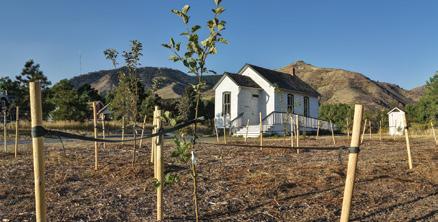
Not only did they enthusiastically agree to help, but they also donated 12 apple seedlings. Using the 1922 Orchard Survey from the Colorado Agriculture College at Colorado State University in Fort Collins, we were able to determine the most popular apple varietals the grew in Jefferson County. Museum volunteer Amber Webb went above and beyond and drove to Montezuma with a friend to retrieve the saplings.
In the meantime, our colleagues and partners in the Golden Parks and Forestry Division prepared the ground in front of the Guy Hill Schoolhouse in the Golden History Park. They tilled the soil, amended it with nutrients, and laid drip irrigation. Afterwards, they planted and staked the saplings. With a lot of love and care, in spring 2022, the little trees should emerge from dormancy and spring forth with beautiful flowers, leaves, and—hopefully—fruit! And, with the generous support of the Applewood Community Foundation, the museum will install interpretive signage and tree identification tags.
We are incredibly excited to see the progress of this new orchard in the years to come. We also know that the orchard will grow to become a beautiful green oasis and landmark in the park. In the coming months, the Museum hopes to initiate a new volunteer apple sleuthing team who will document historic apple trees around the Golden area.
Are you inspired to become an apple sleuth?
Contact Kathleen Eaton, Interpretation and Visitor Experience Coordinator.
KEaton@GoldenHistory.org
DISCOVER I GoldenHistory.org 7
Education
Roundup
Building Colorado is Back!
While Covid-19 has continued to make educational programs difficult, we have been thrilled to be able to re-enter schools with our Building Colorado outreach program. The museum offers two distinct versions of this 90-minute fast-paced game. Cities is the original program created specifically for fourth graders that allows students to examine opportunity costs, incentives, and risks as they explore choices that Colorado cities faced. The Communities program allows third graders to learn about the earliest communities in Colorado as they choose jobs, get paid, and see how key historic events impact different groups of people. We have dreams of expanding this program to other grades.
Are you a teacher interested in helping us develop programs?


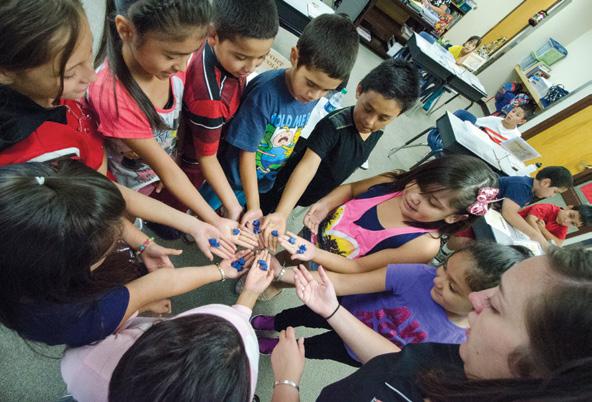
Contact Jesse Gagnon, Student and Family Programs Coordinator.
JGagnon@GoldenHistory.org
Building Colorado Stats
Frontier Explorers:
A New Theme for Hands-on History

New Additions to the Education Teaching Collection
Three artifacts were recently transferred to the Education Department for use in programming. They include a red fox fur, coyote fur, and a box of rocks. The objects have no specific provenance or connection to Golden, which is why the decision was made to remove them from the permanent collection. They will have new purpose

New for the 2022 Hands-on History season, GHM&P will offer a new theme exclusively for ages 9-12 on opposite weeks from the museum’s always popular Silent Stars camp. Frontier Explorers will encourage kids to experience how early pioneers survived on the homestead. Campers will explore history, science, engineering, and art as they learn the medicinal properties of plants, build shelters, dig for minerals, build water wheels, dip candles, and more. Important to this camp will be making connections to issues that pioneers encountered in the past and how we still confront some of those challenges today. Sessions will run weekly between June and August. Space is limited. At the time of printing camp was almost at capacity.
For specific dates, age requirements, times, prices, and activities, visit GoldenHistory.org/HOH
8 DISCOVER I SPRING 2022
August 2021 - December 2021 Number of schools served ........................ 32 Number of classrooms served 85 Total student participation 2056 Total miles traveled by education team 1478
Hands-on History School Break Programs



Join us at the Golden History Museum & Park when school is out! During these half-day programs for ages 6-12, participants will explore science, art, history and more while enjoying the unique setting of our history park, whether it is a visit to the chickens or cooking something in the historic Pearce/Helps Cabin. Space is limited. Dates coincide with no-school days for JeffCo Public Schools.
Enchantments and Mysteries
October 20 - 21, 2022; 9 a.m. – 1 p.m.
In preparation for Halloween, participants will explore the history behind this holiday through games and experiments; there might even be a little magic. Each day will feature a unique schedule; register for both days so you do not miss out. Limited to 20 participants per day.
Historical Concoctions
November 21 - 22, 2022; 9 a.m. – 1 p.m.
Did you know that Jolly Rancher was started in Golden, Colorado, or that Coors made pottery and malted milk for candy bars? Over two days, participants will experiment with mixing and matching materials and ingredients. Each day will feature a unique schedule; register for both days so you do not miss out. Limited to 20 participants per day.
Registration Dates
Registration will open to members on August 1, 2022.
Registration will open to non-members on August 22, 2022.
Pricing (per day)
Member*: $35
Non-member: $45
*Member prices require a current Household membership or higher.
Registration will be through Active.
Location and Daily Schedule
Participants will be dropped off and picked up at the Golden History Museum (923 10th St, Golden, CO 80401). Most activities will take place at the Golden History Park (1020 11th St, Golden, CO 80401) across the creek in the Reynolds education cabin.
Daily Schedule
Morning drop-off: Between 8:45 and 9 a.m. (please make sure you arrive by 9:00 a.m.)
Lunch 11:30 a.m. - 12:00 p.m.
Afternoon pick-up: Between 1 and 1:15 p.m.
Supervision and Ratios
Campers will be supervised at all times by museum staff. There is an average ratio of one teacher for every 12 campers.
Refund/ Cancellation Policy

Cancellations received two weeks before the start of program will receive a full refund.
Registrations received by 4 p.m. the Monday before the scheduled program will receive a 50% refund.
Registrations received on the Tuesday before the scheduled program or later will receive no refund.
DISCOVER I GoldenHistory.org 9
Hal Shelton’s painting Colorado Ski Country USA celebrates one of Colorado’s most popular winter sports. Many consider the original artwork, currently on display in the Legendary People gallery, to be the pinnacle of Shelton’s ski-area paintings. On loan from the Colorado Snowsports Museum Hall of Fame throughout 2022, the original, hand-painted work of art was commissioned by the Colorado Ski Country USA Association. The association asked that all members’ ski areas be depicted at the same relative scale, and, of course, all slopes had to face the viewer—a nearly insurmountable cartographic challenge. Shelton creatively solved the scale
and orientation issues and went on to paint and repaint multiple versions of the map as members joined or left the association. While the ski areas aren’t identified by name in the painting, they’re definitely there if you know where to look.
And if Golden ever had a hometown resort it was Arapahoe East—represented in the center third of the painting. Later renamed Ski Golden, this was the most significant, longest lasting, and closest ski area to Golden and the rest of the Denver metro area.
Journalist John McMillin thoroughly researched this onetime attraction in 1997 for a book that, unfortunately, appears to have never materialized. I consider McMillin’s research to be the best material currently out there, especially since he conducted a number of personal interviews with the main players. The extended excerpt below comes from the 1997 Historically Jeffco in the permanent collection at Golden History Museum & Park.
Want to read more about Jefferson County ski history? Check out Lost Ski Areas of Colorado's Front Range and Northern Mountains, by Caryn Boddie and Peter Boddie.
- Mark Dodge, Curator
Remembering Arapahoe East
 &
&
Ski Golden
By John McMillin
Arapahoe East’s visibility along I-70 helped make it the bestknown of Jeffco’s ghost ski areas. Until recently, the lonely lift towers stood as a mute reminder of high hopes from 25-years past. Arapahoe East struggled valiantly with inconsistent snowfall and insufficient snowmaking equipment. But some believe it was also a casualty of the “Not-In-My-Backyard” syndrome.
Arapahoe East was the brainchild of Larry Jump, who had developed Arapahoe Basin 25 years before. He leased most of the Mt. Vernon Canyon land and purchased 15 acres with two houses as base facilities. According to Jump’s wife, Marnie, some ski activity had taken place there in previous years.
In 1972, Arapahoe East opened with an eight-inch base of man-made snow, recalled instructor and resident Peter Bates. A Denver Post story quoted Jump as predicting that his new venture in the foothills could become more profitable than A-Basin itself. Marnie Jump remembers his goals as more modest. “There were two motives. It was Larry’s idea
that it would be a feeder area for beginners, who would eventually go on to ski at Arapahoe Basin. And we wanted to tap into the market of city skiers.”
A born innovator, Jump sold lift rides up the 550-foot drop by the 20-cent token, charging one token for the Poma lift and two for the double chair. “That idea wasn’t so successful,” Marnie said. “The American public didn’t like it. It was a European idea. And it was a nuisance to collect a token with every lift ride.” Besides, according to Bates, an all-day ticket was only $2. There was lighted night skiing. High school and college teams practiced there. Jump’s snowmaking
10 DISCOVER I SPRING 2022
equipment was never quite enough. Grass showed through in patches even after the 1983 Christmas blizzard, when Arapahoe East boasted the same 36-inch base as Aspen Mountain.
“We had some wonderful snows early on. But then came the January thaws, and wind was always a problem,” Marnie recalls.
Bates recalls that Arapahoe East was so popular at one time that 16 instructors were employed there. Skiers’ cars overflowed the small parking lot to the Grapevine Road. But after four winters, operations ceased, followed by season-to-season uncertainty.
A dispute in 1978 helped seal the ski area’s doom. The resort had already lost $400,000 when Jump petitioned Jefferson County for permission to build an “Alpine Slide” to draw year-round business. “That would allow the area to maintain a social facility,” said Jump, with ski instruction offered through the Jefferson County schools. He collected 3,000 signatures on petitions to support his idea.
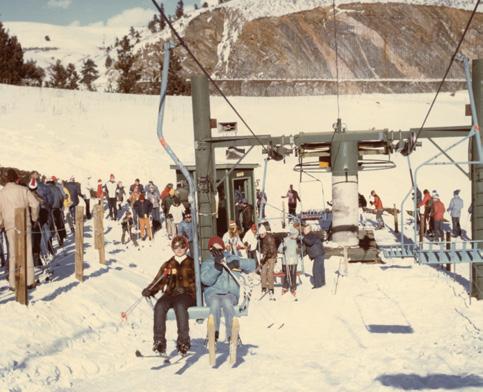
Local attorney Victor Boog represented Jump. Mt. Vernon Canyon resident and attorney Bruce Benson (who ran for Governor in 1994) led the opposition. A public hearing on the plan “was the most horrible experience of my life,” Marnie Jump recalled. “I had never seen such anger and resistance. It was very discouraging. It made me angry, because we had run such a good, clean family area. Neighbors who had left their kids for baby-sitting at Arapahoe East showed up at the hearing to rail against any
further development there. It hurt when they were so hateful to us.”

In one of the most provocative charges, Benson revealed that another alpine slide resort in New Jersey, co-owned by one of Arapahoe East’s prospective investors, included a Playboy Club. Some believe the Board of Jefferson Country Commissioners denied the permit based on visions of real “ski bunnies” in their heads.
Outwardly, Larry Jump remained confident. He believed his scrappy little ski area still held “tremendous potential. With other ski areas becoming overcrowded and expensive, there’s going to be a need for an area like Arapahoe East.”
In 1982, it operated as Ski Golden, borrowing the name of the stillborn resort proposed earlier for Green Mountain. Manager Del Hert’s worries about his fickle snowpack were included in an Up the Creek survey of small ski areas. Hert was quoted saying, “If it isn’t the wind, it’s the dang sun. Every time we get a good snowfall, it’ll stick around a few days. Then I start to sweat.”
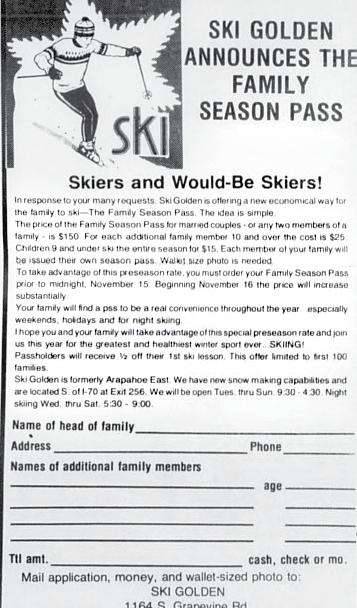
Arapahoe East’s luck bottomed out in 1983, after young promoter Mike Hansen proposed skiing with a long version of

in-line skates on grass slopes. Marnie Jump recalled, “It became a sensation. We were overwhelmed with people, way too many.” But that new sport posed its own lease and insurance problems, and did not solve the dilemma of the area’s skimpy snowfall.
Jump offered to sell the area for $310,000— “the cheapest ski area in the U.S.” In 1995, the land was purchased by the Medved family, who removed the lift towers in 1996. Arapahoe East broke even in only one year, 1973, but for the next 11 years, it was “an orphan waiting for a long, cold winter.”
“It was pretty successful for the first two years,” said Marnie Jump. But as development of I-70 continued west, more skiers drove past Arapahoe East to bigger resorts with much more reliable snow. Denver Post columnist Bob Saile endorsed Jump’s observation that “many city dwellers are less than enchanted with the time and trouble of driving to Western Slope ski areas.” Jump is quoted predicting a “land boom” of homes in Mount Vernon Canyon that would someday dwarf his little ski hill.
DISCOVER I GoldenHistory.org 11
Golden Transcript, November 5, 1981.
Arapahoe East ski lift, undated. Photo © Denver Public Library Special Collections
Do you have memories of Arapahoe East and Ski Golden? Contact Mark Dodge, Curator MDodge@GoldenHistory.org
Photo © Golden History Museum & Park, City of Golden Collection
Collection Corner
We’re now three years into our Legacy Collection Inventory – a full audit and rebuild of our 14,000 permanent collection records. Here you’ll see images of some of our most recent acquisitions as well as some rediscovered items.

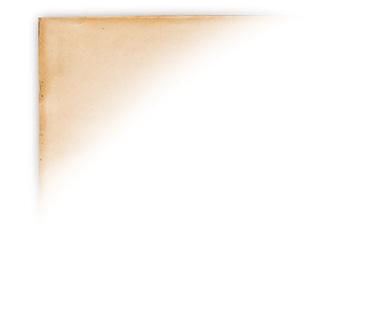
Inventory rediscovery
Richard Broad Jr.’s, silver crumber and engraved brush, c. 1900.
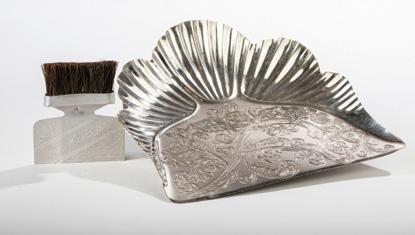
Inventory rediscovery




Virginia Mallen Chauvenet’s handcrafted Battenberg lace coat, 1895.
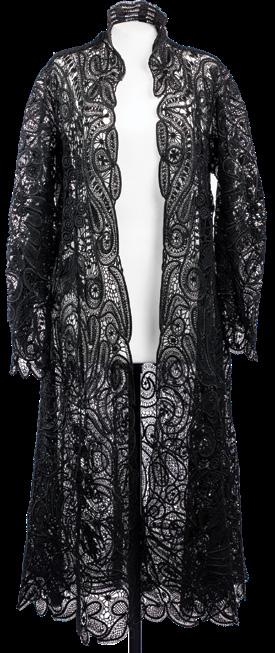
New acquisition
Golden Savings & Loan Association ashtray c. 1960s

New acquisition
Golden Oktoberfest mug, September 1983.
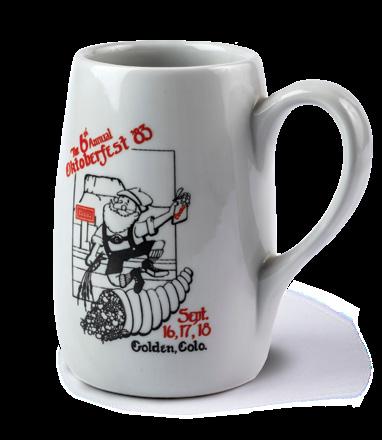
12 DISCOVER
SPRING
I
2022
Photos © Justin LeVett Photography
Inventory rediscovery





“Invest in the Victory Liberty Loan,” WWI poster by L. A. Shafer, 1919.
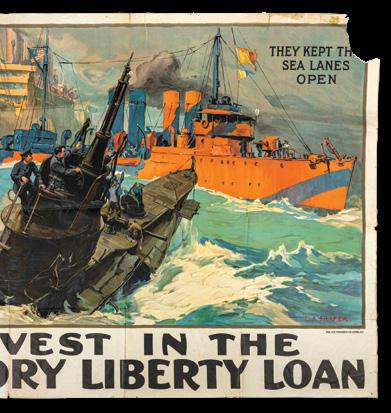
New acquisition
Sheepskin teddy bear made by Janney Collins, owner of Carleen of Golden Tailoring and Alterations, c. 1980s.
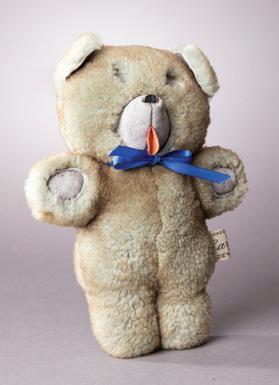
New acquisition
Jody Babb’s Golden High School cheerleading vest and beanie, 1953.
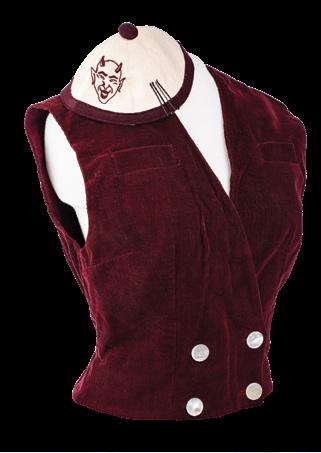
New acquisition
Dollar bill stamped “Boycott Coors,” collected during the 1977 Coors Brewery strike.
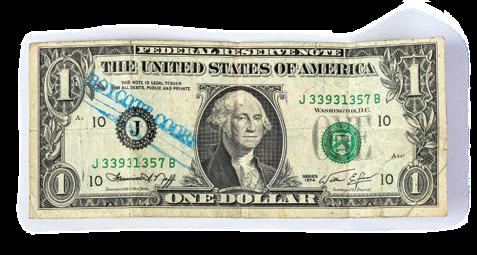
New acquisition
Handcrafted papoose doll made by Golden resident Ashley Bussert for his daughter, c. 1910.

Do you have an object, photograph, or document that you would like to be considered for donation?
Contact Mark Dodge, Curator. MDodge@GoldenHistory.org
DISCOVER I GoldenHistory.org 13
Artifact Conservation: Investing in the Future of the Past
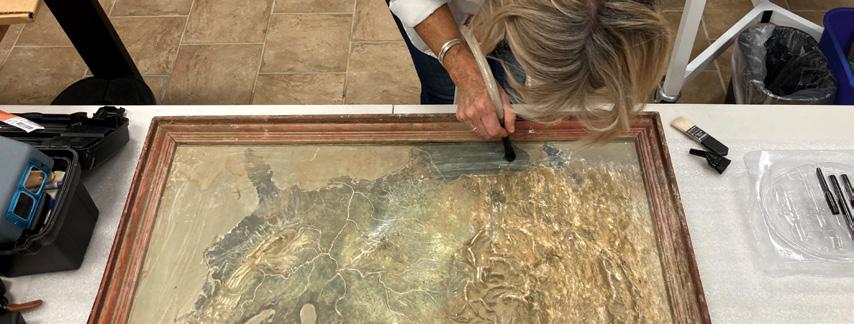 By Nathan Richie, Director
By Nathan Richie, Director
The mission of Golden History Museum & Park is to engage and inspire visitors by preserving and sharing Golden’s history. Preserving history takes many forms at the museum. Staff members collect artifacts, digitize and make accessible documents and photos, and also store thousands of objects, tracking minute details on each one, including condition, location, and more. Many of these objects, while highly important and often rare or one of a kind, are not always in the best shape. There are lots of contributing factors that can lead to disrepair. Aside from regular wear and tear, items often come to our collection damaged, missing components, no longer operational, or really, really dirty. In some instances, the objects themselves are made from or stored in harmful components like acidic paperboard that can burn sensitive materials. Sometimes the materials like plastics or other synthetics break down overtime. Objects can be water damaged or suffer from mold. And sometimes pests from bookworms to moths or mice can damage objects by consuming them or leaving waste. There’s no shortage of things that can happen to an object
over time. Each item requires a unique treatment—and the skills of a specialized conservator—to keep them looking their best and to ensure their longevity. The following are a handful of highlights of recent GHM&P conservation projects and a few projects in the queue for 2022.
Relief Maps of the World
Six rare plaster maps depicting the continents of the world (sans Antarctica) once graced a classroom in South School, predecessor of Golden High School. The maps were salvaged from the attic of South School prior to demolition and then stored for over 50 years in the loft of a cabin in Mount Vernon Canyon before given to the museum in 2021. Covered in decades of dust and bird droppings, the maps will be thoroughly cleaned, and loose plaster secured with conservation adhesive. Plaster and paint losses will be infilled.
Koenig 38-Star Flag

This gigantic flag (12’ x 24’) was discovered by Nick Koenig who owned and operated a dry goods store located in the Loveland Block building that once served as
Colorado’s territorial capitol. The handsewn 38-star banner is from the era of Colorado statehood and was the US flag from 18771890. The banner is so huge that the museum partnered with History Colorado in Denver to have a space large enough to unfurl the textile to clean, stabilize and repair.
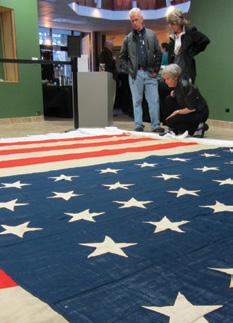
14 DISCOVER I SPRING 2022
Calendar and Grandfather Clocks

In 2020, GHM&P acquired two unique timepieces: an 1890 Seth Thomas calendar clock from Tierney Jewelers and a 1980 Ridgeway grandfather clock that once stood in Woods Mortuary. Both had movements removed, cleaned and repaired. Chime mechanisms were fixed and both restored to operational order. Scan this QR code to watch GHM&P curator Mark Dodge and clock conservator Mike Korn work on the grandfather clock.

Golden Post Office Safe
The Golden Post Office purchased a Diebold safe in 1903. The two-ton behemoth was moved multiple times, finally landing in Tierney Jewelers where it was used by three different merchants. It was moved to the Golden History Museum in 2021. The ornate scenic painting and the hand painted lettering on the front of the safe will be cleaned and losses in-painted.
William A. H. Loveland Portrait
Pearce/Helps and Reynolds Cabin Roofs
The historic Pearce/Helps and Reynolds cabins were built in the 1870s in Golden Gate Canyon. The structures were disassembled and rebuilt in the Golden History Park in the 1990s. As part of routine maintenance and preservation, both were reroofed in 2021. The work was done by preservationist Bill Granda following the Secretary of the Interior’s Standards for the Treatment of Historic Properties. The cedar shakes have been firetreated in accordance with modern building code requirements.
Golden Cemetery Map and Ledgers

Platted in 1873, Golden’s cemetery is one of the oldest in the state. In 2019, the cemetery transferred to the museum the original cemetery map and first two cemetery ledgers, which were in poor condition. The ledger was unbound, pages then collated and resewn. The map was cleaned and removed from a linen backing and placed in conservation materials.
Golden Cemetery ledger after completion of conservation work.
This portrait of Golden founder William A. H. Loveland once hung in Fire Station One. The painting was exposed to years of soot from coal heating, cigarette smoke, exhaust, and other grime. In 2017, the painting was cleaned, paint loss in-filled, varnished, and its frame reconfigured with conservation quality materials.

Investing in the Future of the Past
Conserving an object is both time consuming and costly. Museum staff continuously review and report on artifact conditions to make prioritized lists of which items need the most immediate attention and care. The museum designates a portion of its annual collections budget to conservation but relies on other financial sources to make work possible.
The Denver Foundation’s Greenwood Fund was established in memory of Charles






“Carl” Greenwood Patterson III, Director of Conservation at the Denver Art Museum for 18 years. The fund was created to specifically help small museums in Colorado and Wyoming with conservation assistance. Golden History Museum & Park has received nearly $10,000 in grant support from the Greenwood Fund since 2011 and has completed numerous projects as a result. In an ongoing effort to improve the quality of the collection, the museum is in the midst of a Legacy Collection Inventory. Objects that are in the museum’s custody that do not have documented history or do not have a tie to Golden, are removed through a process called deaccession. After a lengthy review and approval process, objects that are deaccessioned are often sold at auction. Proceeds of those sales are reserved in an escrow account to be used exclusively for acquiring new and conserving existing artifacts.
In spring 2021, Bill McKee, beloved former president of the Friends of Golden History Museum & Park, passed away after a battle with leukemia. In honor of his commitment to the museum and his love of history, the Bill McKee Family Collection Fund was established to advance the museum’s collecting and conservation practices. This fund will catalyze the museum’s conservation program over the coming years.
DISCOVER I GoldenHistory.org 15
Inspecting the Koenig 38-Star Flag.
Cynthia Lawrence examines a plaster relief map from South School.
Photos © Golden History Museum & Park, City of Golden Collection
Clock conservator Mike Korn examines the 1890 Seth Thomas calendar clock.
efforts?
to GoldenHistory.org/donate
Cynthia Lawrence examines the 1870s Loveland portrait prior to a treatment.
Do you want to support GHM&P’s conservation
Go
with the Big Pictures: Little Theater The Gem The
By Mark Dodge, Curator
Many a Golden resident who grew up here between the 1940s and ‘60s gets nostalgic about the city’s last real movie theater. Over the years it went by different names: the Gem, the Golden Gem, and finally the Golden Theatre, before it closed forever in 1975. First established in 1908 in what was then the old Christian Church building in north Golden, it changed locations and ownership a few times before finding a permanent home at 1301 Washington Avenue.
Golden’s movie house was built in 1911–1912 as a dual-use facility, housing the Gem Theatre on the first floor and the Golden Athletic Club on the second. The theater opened on June 1, 1912, with about 300 seats. The building remains today, but instead of movies and popcorn it’s home to restaurants and offices.
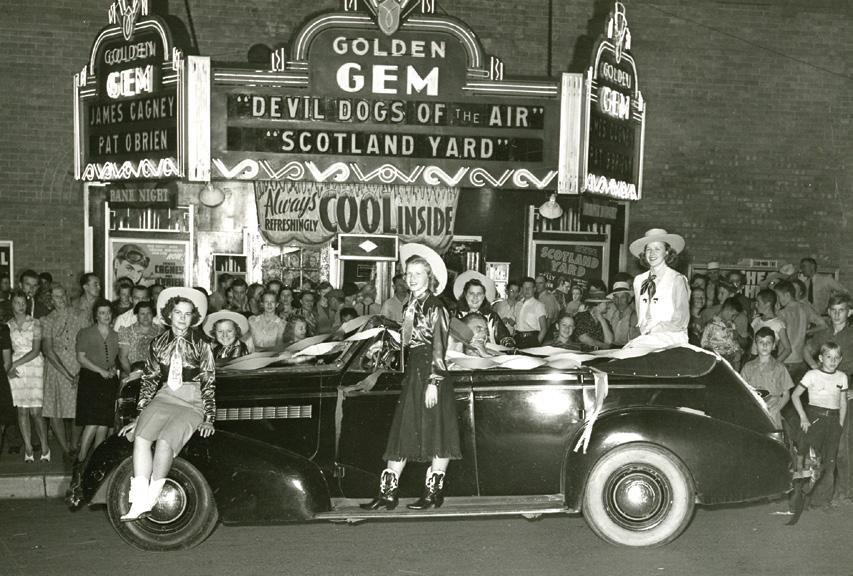
The first of nearly half a dozen remodels was completed in 1926 and included a Photoplayer theater organ. The Donavan Case, Golden’s first “talkie,”
premiered in June 1929.
Over the years the movie palace went through at least three major remodels before it fell on hard times in the late 1960s and briefly showed pornographic films. It temporarily closed in 1970, but then the Foss family bought it and brought back PG-rated family fare in 1972 (talk about a flip-flop). After a major remodel in 1976, the old theater was converted into retail space and reopened as Steve’s Corner, a local western wear store.
16 DISCOVER I SPRING 2022
Fresh Perspectives
At the museum, we rely on firsthand perspectives in recounting local history. Following are three unique memoirs about the Gem.

Virginia Preuss MacLeod
German immigrant Richard Preuss and his wife, Barbara, bought the theater building in 1928. In 1966, their daughter, Virginia, shared this memory:
“My Mother and Dad were in the show business since 1922, at which time they operated the Arvada Theatre in Arvada, Colo., which they operated till 1928. In the

fall of 1928 the folks purchased the show in Golden from Martin McFarland. One of the first things Mom and Dad did when they took over was to drop the prices in admission so the town people could afford to go to the theatre. Martin McFarland had prices at that time 50¢ for adults and children 25¢. My folks dropped the price to 25¢ for adults and 10¢ for children and that price was carried thru all the years they had it, till they leased the show out to C.U. Yaeger of the Atlas Theatre Corp. My Mother thinks the time we leased it out was around 1935 and in 1945 Mr. Yaeger bought the theatre.

“Dad and Mom brought the first sound or talking picture in Jefferson County to our




DISCOVER I GoldenHistory.org 17
Photos © Golden History Museum & Park, City of Golden Collection
Advertisement for the Golden Gem, 1919.
Intersection of 13th St. and Washington Ave. in 1914 with Gem Theater on the right.
Golden’s Gem Theater in August 1941.
The first silent films in Golden were shown at the old Christian Church in 1908.
Continued overleaf
show in 1929. I myself will never forget the look on the people’s faces when my Dad surprised them at the end of the show one night with a talking trailer that he put on the screen. I can clearly remember when the sound equipment came in on the train to Golden and Dad was so excited he worked all night and the next day so that he could give the people of Golden a surprise that they never expected, as the Aladdin Theatre was about the only theatre who had talking pictures that I can remember who was close and then the prices were so high that not many people could afford to go to them. The name of this sound equipment he first bought was Vitaphone. The next day Golden was buzzing about the talking picture they had seen at the show that night, it was really a thrill. Then in 1931 they purchased the new equipment, which was put out by RCA, and [they] got a new beaded screen. They had to have the whole show’s wall lined with cloth so that the sound would sound right. They always called the Golden Gem the Little Theatre with the Big Pictures, as many was the time we had first-run pictures playing with the same that were running in Denver.

“How well I remember when Dad and Mom made arrangements to bring Leo the Lion to Golden; he was the Metro-GoldwynMayer lion that was at the beginning of the picture. How the people turned out to see him in the big cage. [I also remember] the yearly Xmas parties that we had for the children. And how he would always try and get some attraction that one of the big Denver theatre[s] would have. Perhaps you remember the “Wonder Girl” that we had
on; she came on the stage and the people could ask her questions. . . . When we first took over, my Mother sold the tickets, my Dad [ran] the machines in the booth, and I took tickets because when we first took over the town people would hardly come into the show as the [School of Mines students] . . . would throw lighted cigarettes over the balcony and spit on the people below. But it wasn’t long till my Dad got everything under control. He told anyone and everyone of them that he caught to stay out of the show [and] that he didn’t want them as customers; if they couldn’t come into the
show and have respect for the people in it he didn’t want their business. But the Miners had lots of respect for Dad and it wasn’t long till they were good. My folks gave Golden a show that they could be proud of and all thru the years he kept the prices down so that everyone in Golden could have a place of good entertainment. After the folks leased out the show the first thing the new owners did was raise the prices as they said they couldn’t run a show on those cheap prices. But Mom and Dad always manage[d] to, and I think the people then realized that they did get a bargain in entertainment.
“My Dad and Mom always had faith in people; they gave many a person a start in life and some were very successful, and they never expected a thing out of it, they were just glad they could do it. Many was the time I seen [sic] people come to the house and tell my Dad the bank wouldn’t give them any money and they were [losing] their house or something of value and he knew they were good people. He gave to them and never took nothing in return but their word that they would pay back. He never thought bad about anyone and there were so many little people in Golden he helped get over the rough years. He and my mother and myself knew what he did and always felt very good about [it].”

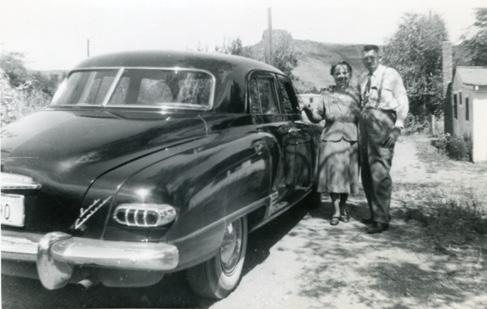
18 DISCOVER I SPRING 2022
Richard A. and Barbara M. Preuss, about 1940s.
The Golden Gem Theater and newly remodeled Preuss building, about 1935.
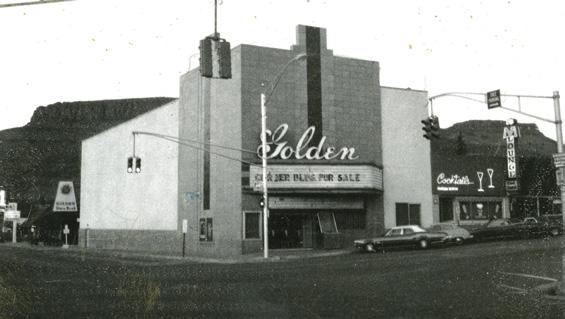
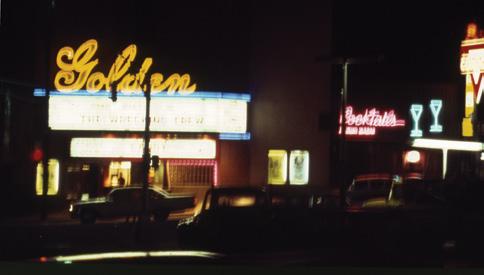
This lifelong resident journalist and local historian shared her account:
“A little item on shows at this time. In 1913 I remember they ran a serial, as they were called. This was all silent film. As an example, ‘Perils of Pauline’ was a thriller. Each week one reel of this exciting story would be shown and [it] always stopped at a most breath-taking moment, such as leaving the heroine hanging by her hands over a very high cliff, or some such spine tickling (sic) episode and the flash on the screen would be ‘To be continued next week don’t miss it come and see Pauline rescued.’ It went on for weeks and one reel each week and the crowds packed in each week.”
From “A Vacation in Colorado, July 4, 1941, to August 1, 1941,” Harold recalls: “The only movie house they have in Golden is the Gem. It is only about the size of the Strand back here [in Denver]. However it is a very nice little movie house and it gets pictures right after they leave the best shows in Denver. Therefore the Gem is a first rate theater and it isn’t like the Strand in that respect. The two pictures we saw that night were “Love Crazey [sic]” with Myrna Loy and William Powel[l]; and the “Flame of New Orleans” with Marlene D[i]etrich. Both pictures were good and of course there was the news and 1 or 2 other short subjects.”
Exciting donation:



The museum now owns five pallets’ worth of movie projection equipment from the Gem, donated by John Nawlen and family, former owners of the theater. Among the items, both large and small, is this lighting source for the Simplex twin projector, on display at Golden History Museum. The equipment was discovered by Curator Mark Dodge in the summer of 2021.

DISCOVER I GoldenHistory.org 19 Do you have a good story to share about the movies or any other “gems” of Golden history? Contact Mark Dodge, Curator. MDodge@GoldenHistory.org
Irene Goetze
Golden Theater marquee at night taken by Golden resident Kenneth Hottinger, April 1969. This Golden night scene is rare, even if it’s a little blurry.
Golden Theater for sale after it closed in 1975.
Harold Miner
Staff Profile
Jesse Gagnon
Ifind the past fascinating. It was not uncommon for me to have a book on some historical topic spread out at the kitchen table as a kid, though I distinctly remember my mother asking me to remove my Egyptian mumification book from the breakfast table. My first experience of museum work was as a high school student, when I started volunteering after school at my local historical society in Kingston, Rhode Island. Each week, I would ride the bus to the historical society and help wherever I was needed. This mostly entailed working with the collections where I helped affix labels to newly accessioned items, but I also assisted with exhibit setup and public events. This experience proved formative, and I kept coming back to museum work as I pursued a dual degree in History and Spanish at the University of New Hampshire and then continued my education through the University of Delaware’s Master’s program in History and Museum Studies. During my time as a graduate student, I found that I was most at home working in small museums, helping them figure out how to create engaging activities and programs on
shoestring budgets. This scrappy mentality served me well when I started my first museum job at the Marshall Steam Museum in Yorklyn, Delaware. While my responsibility was to start the museum’s educational programming for K-12 students (and decide what that would even mean), as one of only two staff members but a large group of volunteers, I got to experience the sheer variety of responsibilities a small museum must manage simultaneously such as marketing, fundraising, publications, exhibit development, and making sure the floor was vacuumed. While I took a break from my museum career when I moved to Colorado at the end of 2016 to work in parks and recreation, I am now thrilled to be Golden History Museum & Park’s new Student & Family Programs Coordinator. Among my goals are to make sure that our core educational initiatives of Building Colorado, our Jr. Homestead Days field trip experience, and our Hands-on History summer camp are returning to pre-pandemic participation levels as much as possible, but also to ensure that families and children feel welcome and included in our museum experience.
Volunteer Profile Mike Wood
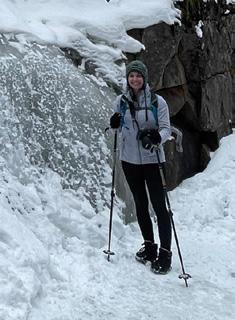
Mike and his wife Mary moved to Golden in 2016 to be closer to their two children and three grandchildren, as well as enjoy the many outdoor activities that Golden has to offer. Mike began volunteering at the museum in 2017.
Mike studied economics and business, earning his BS at West Virginia University and MS/MBA at North Carolina State University. He spent the greatest part of his career developing and managing supply chain and manufacturing operations strategies at Anheuser-Busch Companies, Inc. (A-B). He held materials planning,
finance, procurement, operations, and technology development positions. These positions culminated in his leadership of the vertically integrated ingredient research, manufacturing, and raw material supply company of A-B known as Busch Agricultural Resources, Inc. (BARI). He was elected an officer of Anheuser-Busch Companies and member of the domestic and international Board of Directors for BARI.
Mike loves interacting with the Museum’s and Park’s guests and answering their questions. His interests include brewing and distilling, gardening, fishing, golf, and hiking.
A graduate of Leadership Golden’s class of 2017, Mike served on Golden’s Economic Development Commission as Chairman. His current volunteer activities include serving as President of the Friends of Golden History Museum & Park, helping staff coordinate the History Park’s Heritage Garden, and assisting with building and repair projects as needed.

20 DISCOVER
SPRING 2022
I
Legendary People Steve Schaefer
I am thankful that I have been able to be a part of Golden’s history—but more importantly, thankful to the Golden community that has supported our family hardware store for over 76 years.


As a teenager, I’d walk across Clear Creek from my junior high school to my family’s hardware store, spending my afternoons assembling bicycles, mopping the floors, and eventually working on the sales floor helping customers. Little did I know that I’d continue my family’s legacy there for over 45 years.
I was born in 1955 and spent my infant and toddler years living in an apartment above the original Meyer Hardware at 1110 Washington Avenue. It was that store— started by my grandparents Joe and Ruby Meyer—that would become my life’s ambition. My parents, Harold and Marilyn Schaefer, and my siblings, James, Kathy, and Pat, all played integral roles in the store’s history as well.
I attended St. James Lutheran and Earle Johnson elementary schools, Golden Junior High, and Golden Senior High. During my
high school years I was a member of the Golden Centennial Singers, was chosen as a member of the Colorado All-State Choir, and got involved with the Student Council, serving as boys’ vice president my senior year. After graduating in 1973, I continued my education at Pacific Lutheran University, graduated with a business degree, and married my wife, Karla. It was then that I returned to Golden and a 45-year career at my family’s store.
As I got more involved with managing the store, I took part in three major expansions and remodels, becoming corporate president in 1996. Just like I had, my brother James started working at the store during high school. He stayed by my side until we closed the store in the fall of 2021. He was the one who knew where to find everything, and he was liked by everyone who came in to shop. Rarely did
he miss a day of work—he was usually one of the first to arrive, and often one of the last to leave. And he was always the one to volunteer when I needed extra help.
During the 76 years that Meyer Hardware was a member of the Golden Chamber of Commerce, both Joe Meyer and Harold Schaefer served as the chamber’s president. I, too, served as a director on the chamber board, and on the chamber’s retail committee for over 20 years. In 2010, I was honored to receive the Golden Rotary’s Ethics in Business Award—an award that I accepted on behalf of three generations of the Meyer family.
DISCOVER I GoldenHistory.org 21
From left, James Schaefer, Steve Schaefer, and Craig Sarensen. Photo © Golden History Museum & Park, City of Golden Collection
‘‘ ‘‘
Visit GoldenHistory.org/blog for more photos of Meyer Hardware staffers and artifacts.
—Steve Schaefer
Programs
These programs are subject to change. Go to GoldenHistory.org/events for the most up-to-date details.
Programs are free for members and $10 for non-members (plus eventbrite fee), unless otherwise noted.
All activities at Golden History Museum unless otherwise noted.
April 13, 2022, 6 p.m.
Golden – Colorado’s Territorial Capital
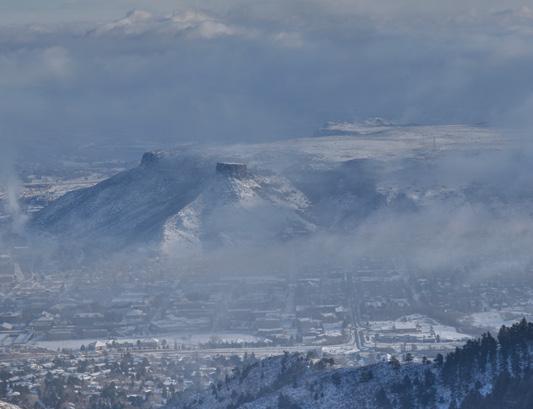
Join returning presenter Randi Samuelson-Brown to uncover the stories of Golden’s wilder days when the population was scarce.
May 4, 2022, 6 p.m.
A Walk Through Time on South Table Mountain
Mary Elizabeth Eiberger shares the complicated history of Golden’s South Table Mountain and the 24-year battle for its preservation led by her father, attorney Carl F. Eiberger Jr.
May 18, 2022, 6 p.m.
Isabella Bird’s Visit to Colorado
Acclaimed storyteller Linda Batlin performs a costumed interpretation of Bird’s 1873 travels in Colorado.
$5 for museum members, $10 non-members (plus online registration fee)
June 29, 2022, 6 p.m.
(rescheduled from January 2022)
Golden: Then & Now
Learn how geophysicist Stuart Sipkin used modern mapping and Geographic Information Systems to observe Golden’s changing landscape over time. Castle Rock: then and now.

July 13, 2022, 6 p.m.
Reimagining Post Industrial Golden
Join Bianca Barriskill to see how Golden repurposed some of its own industries into tourist attractions and became a preferred destination.
Golden’s Welcome Arch, 1997.
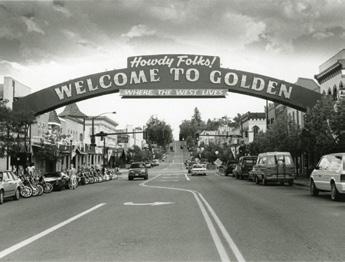
22 DISCOVER I SPRING 2021 2022
South Table Mountain. Photo © Andrew Terrill
1 1 3
Photos © Golden History Museum & Park, City of Golden Collection unless otherwise noted.
2 2 3
October 2, 2022, 10 a.m. – 3 p.m. Autumn Fest
Autumn Fest is a free celebration of Golden featuring hands-on activities for the whole family, including crafts, big trucks, and even farm animals. Mark your calendar now!

June 8, July 6, August 10, 10:30 a.m. – 12 p.m.
Hands-on Family Activities at the Museum
After enjoying a free story time presented by the Golden Library on the grass outside the museum, visit the museum for free drop-in activities.

October 27, 2022, 6 – 8 p.m. History Trivia Night
Build a team and join us at the museum for a special history trivia night! There will be themed categories about both Golden and Colorado. Teams (of no more than 4) will test their knowledge and vie for the title of champion. Advance registration is required. Light refreshments and snacks will be provided.
$20 per team for members, $30 per team for non-members
June 11, July 9, August 13, 10 a.m. – 2 p.m. Homestead Open House Golden History Park
Interested in seeing sparks fly at the blacksmith shop, taking a lesson at schoolhouse, or watching the Pearce/Helps Cabin woodstove in action? Visit us on the second Saturday of each month for free drop-in, hands-on activities.

June 23, July 28, August 25, 5 – 7 p.m. Evening at the Museum
This summer, Golden History Museum & Park introduces “Evening at the Museum.” During June, July, and August, the museum will be open late on the fourth Thursday of each month. Drop in on any or all of these dates for free hands-on activities, artifact highlights, and the chance to chat with a curator. 6
Blacksmith at work.
DISCOVER I GoldenHistory.org 23 4
5
6
Photo © Povy Kendal Atchison
5
Photo © Povy Kendal Atchison 4
Bill McKee In Memory of
Bill McKee, longtime president of the Friends of Golden History Museum & Park, passed away on February 7, 2021, at age 68 following a calm and mighty battle with acute myeloid leukemia. Bill was born in Lake Forest, Illinois, and grew up in Barrington, Illinois. He graduated from Barrington High School in 1970. Bill’s love for skiing and the mountains made attending the University of Denver a perfect fit. Bill graduated from the University of Denver in 1974 with a B.A. in Political Science. Soon, he received his Masters of Urban Affairs, with an emphasis in Budgeting and Administration in 1977 from the University of Colorado.
Among his many passions, Bill worked for The Colorado Department of Health and Environment with the Water Quality Division for 26 years. He effected positive changes to protect the rivers, lakes, and streams of Colorado. Bill influenced how various jurisdictions were expected to comply with the
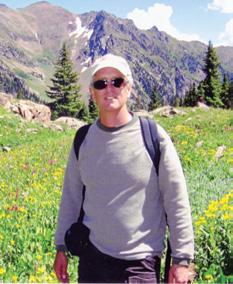
New Exhibit
Signs
Clean Water Act. Whether working with grants, permits, regional planning, nonpoint source pollution or as the Upper Colorado Watershed coordinator, Bill realized water pollution was about all of us working together.
Bill and his wife Suzy met through common friends in 1978. They married in 1979 at Pine Valley Ranch in Pine, Colorado. Soon, they moved to Golden, Colorado. During those 38 years in Golden, Bill was constantly working to improve his community. Bill embraced Golden, as he did water. He served from 1988-1996 on the Golden Planning Commission; he was elected to the Golden City Council from 1996-2004. McKee’s time on both city council and the planning commission coincided with important changes in the history of Golden. Alongside fellow city leaders, McKee worked to revitalize downtown and bring more business and tourism to Golden. Many of Bill’s lasting contributions were to the boards
O’The Times
By Mark Dodge, Curator

Old signs are powerful evidence of the changes Golden has experienced. Simply put, signs are visual graphics we use to communicate information to each other. We’ve used them for thousands of years, and if you stop and look around, they’re everywhere. The permanent City of Golden collection currently cares for more than two dozen commercial and business signs. Plan to stop by and see five we’ve acquired from our recent past:
The Golden Outlook newspaper, about 1970s
Big “M” Restaurant and Lounge, about 1965

Big Tree Mobile Home Park, about 2009
Golden Lodge No. 13, I. O. O. F., 1952 (this neon was restored to working order especially for this show and will be illuminated.)

Carleen’s of Golden, about 1980
Together, they make a nice snapshot of our rich business history from the 1950s to 2010.
and organizations for which he served. Bill was president of the Friends of Golden History Museum & Park group for many years and helped shepherd the organization from a volunteer outfit to the professionally run museum it is today.
In honor of Bill’s love and dedication to Golden’s history, the Bill McKee Family Collection Fund was created for the Friends of Golden History Museum & Park. The fund will be used to help the museum conserve objects, acquire new artifacts, and secure and protect the collection for future generations.
22 DISCOVER I SPRING
24 DISCOVER I
2021
SPRING 2022
Upcoming Exhibits in The Salon
Homelands:
Artwork by Arapaho and Cheyenne father and daughter artists George Curtis Levi and Halcyon Grace Levi February 12 – June 4, 2022

George Levi is a member of the Southern Cheyenne Tribe and is also part Arapaho and Sioux. Of his art, Levi explains, “My work is about my people, it’s about who I am, where I come from. It’s about a history that still lives on. The types of work that I do are Cheyenne style ledger drawings on historical paper, watercolors, acrylic paintings, parfleche/ rawhide work, and Cheyenne beadwork.” Levi’s work is currently in university collections, galleries, and museums across the U.S. and the world.

Levi continues, “This art exhibit is about the History of The Cheyenne and Arapaho People who call present-day Colorado their Homelands. The Cheyenne and Arapaho People lived in and loved this area and Colorado until they were forcibly removed in the 1860s and this show is a part of Renewal, the Return of Cheyenne & Arapaho People to part of their Homelands to tell their story as Cheyenne and Arapaho People.”
Rick Souders:
The Art of Edible Imagery
June 9 – October 2, 2022

Golden-based food photographer Rick Souders creates sumptuous, mouthwatering imagery for food and beverage advertising campaigns worldwide. Rick’s unique creative and business background has allowed him to work at a Fortune 250 Beverage Company, then on to one of the largest advertising agencies in the US, to owning one of America’s top food and beverage photography studios. Souders Studios was selected Top Beverage Photographer three consecutive times at the World Food Media Awards in South Australia. Rick grew up on the rural high plains near the Pawnee National Grasslands. His passion for food and agriculture runs deep and he credits his upbringing for playing a formative role in his development as a food and beverage photographer. Said Souders of his art, “Working with light, texture, color, form and shape is so amazing to me. Then add food and beverage and you simply can’t go wrong. My food art photography combines my interest in color theory and color psychology. The use of color, light and texture is both harmonious and jolting. The food is graphic, textural and tonal and creates its own story. The crisp colors, amazing textural depth and quality of light is stunning. I create images to satisfy my creative hunger.”

DISCOVER I GoldenHistory.org 23 DISCOVER
Image © George Curtis Levi and Halcyon Grace Levi
Image © Rick Souders
Golden History Museum & Park
Donors
January — December, 2021
Linda and Dale Baker
The Denver Foundation, Greenwood Fund

Downtown Development Authority
Mark and Nancy Foster
Golden Civic Foundation
Richard and Cynthia Bauman
Jennie and Charles Boeder
Lydia Andrews-Jones and Jason Matisheck
Michelle Barnes and Rick Taylor
James and Joy Bauman
Bill and Carol Bleau
Shelly and Nick Bleckley
Betty Bloom
Sarah and Joe Brenkert
Gerald E. Brown
John and Kathe Buhr
Nancy and Dick Bureson
Linda Churches
Thomas and Julie Clark
Jim and LouAnne Dale
Jim and Odile De La Beaujardiere
Ingrid Depta
Pat Donahue and Kevin Skeate
Kathleen Doyle
Ted and Paula Dreith
Edward Jones
Ewers Architecture
Sheryl and Steve Fassino
Katherine and Garrett Fleming
Kristine and Kevin Fletcher
Richard Flint
Larry and Barbara Foos
Norma Fricke
$10,000+
City of Golden
Scientific and Cultural Facilities District
$1,000 — $9,999
Golden Kids Dental and Orthodontics
Connie Hauver
Kathleen Weller Horky and Kevin Horky
Elaine and Joseph Marolla
McKee Family Foundation
$500 — $999
Justin LeVett Photography
Sharon and Robert Kirts
$100 — $499
Dorothy and Michael Gleason
Betty and Thomas Gleaton
Wendy and Rick Goad
Martha Gould
Gene Gray
George Griffin
Elnore and Ron Grow
Lynne Haigh
Paul and Vivian Haseman
Margaret B. Henderson
Steve Hughes and Sue Cornish
Frank and Gaye Jacobs
Joyce Jennings and William Cox
Janet Johnson
Paul and Karen Jones
Rachael Kenney-Reid
John and Karen Lynch
Esther and Don Macalady
Mary Anna and Walter Madden
Helen McVey
Tara Meininger
Meyer Hardware
George Meyers and Merrill Wilson
George and Susan Mitchell
Jan Monnier and Mike Fehn
Geraldine and Mel Moore
William and Jean Parfet
Pat Spieles
John and Andi Pearson
Danielle and Louis Samuels
Lynette and Jeffrey Vann
Justin and Sarah Wade
Pat and Judy Madison
Jean Theobald
Wendy Potthoff
Julie A. Ramstetter
Charles and Mary Ramstetter
Stony and Theresa Shelton
Jane A. and Kim E. Sikoryak
Jack and Catherine Skokan
Susan Speer
Larry and Penny Storms
Sherry and Roger Stuart
Stephen and Beatrice Szadokierski
Cynthia Szymanski and Jason Robertson
Michael and Marla Tamburro
Michael Tamny and Cynthia Merrill Tamny
Clare and Charlie Taylor
Dixie Termin and Ron Miller
Marsha Trout
Barb Warden and Frank Blaha
Jon and Judith Watson
Larry and Betty Weaver
Tom Weimer
Laura and Michael Weinberg
Angela and Tom Wheaton
Jeanne Whittaker
J. Richard and Judith Williams
Mike and Mary Wood
Alan and Elizabeth Woodard
26 DISCOVER I SPRING 2022

DISCOVER I GoldenHistory.org 27 Membership Be a part of Golden history. Become a member today! Join or Renew Today Call, mail, or stop in. 923 10th St., Golden, Colorado 80401 l 303.278.3557 GoldenHistory.org/member Thank you for supporting Golden History Museum & Park YES, I want to support Golden history. Director’s Circle ($1,000) Founder ($500) Benefactor ($250) Patron ($125) Household ($75) Dual ($60) Individual ($40) Seniors (65+) may deduct 10%. Please accept my extra, tax-deductible donation of $25 $50 $100 $ (other) Total enclosed $ Name Address City, state, zip Credit card # Exp. date Signature Phone Email (opt-in for e-newsletter, opt out anytime)
Sunday, October 2, 10 a.m. - 3 p.m.

Autumn Fest is a free celebration of Golden featuring hands-on activities for the whole family, including crafts, big trucks, and even farm animals.
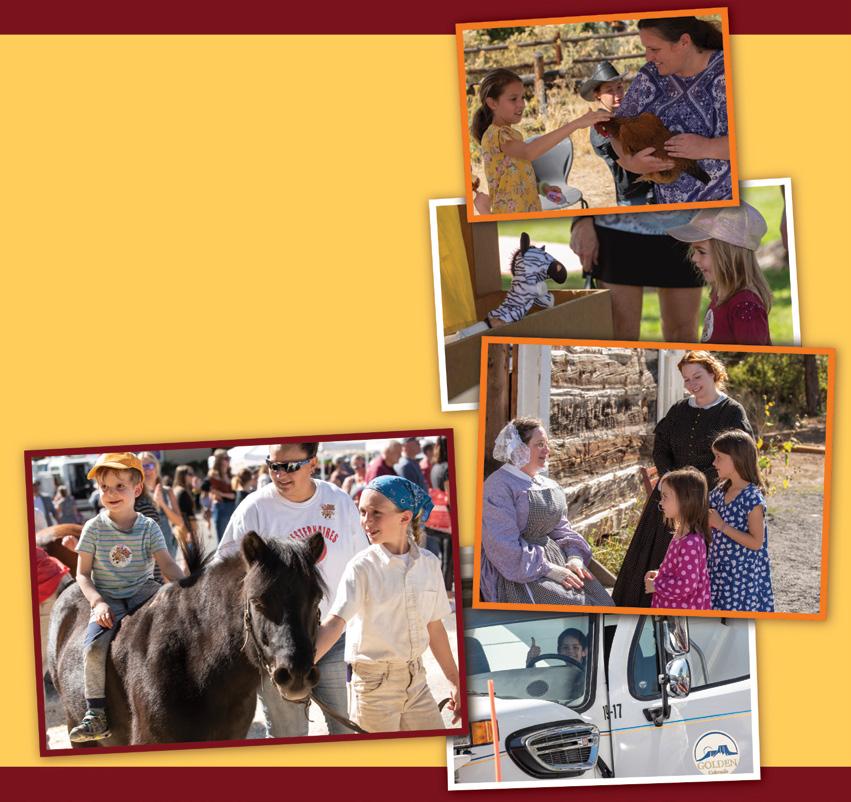
Join us to welcome the fall season at Golden History Museum (923 10th St.), proudly sponsored by: O’Sullivan Personal Injury Law Firm Golden Downtown Development Authority Golden Kids Dental and Orthodontics
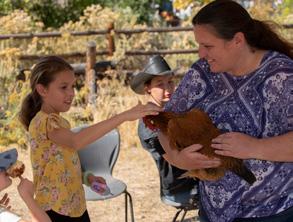
923 10th St., Golden,
80401
Colorado

 Nathan Richie Britton Taylor
Mark Dodge Vanya Scott Director Education Assistant Curator Curatorial Assistant
Nathan Richie Britton Taylor
Mark Dodge Vanya Scott Director Education Assistant Curator Curatorial Assistant
 Jesse Gagnon Kathleen Eaton
Doug Skiba
Andrew Terrill Student and Interpretation and Development and Graphic Design Family Programs Visitor Experience Communications, and Layout Coordinator Coordinator Editor (Discover) (Freelance)
Jesse Gagnon Kathleen Eaton
Doug Skiba
Andrew Terrill Student and Interpretation and Development and Graphic Design Family Programs Visitor Experience Communications, and Layout Coordinator Coordinator Editor (Discover) (Freelance)

























 &
&













 By Nathan Richie, Director
By Nathan Richie, Director



































